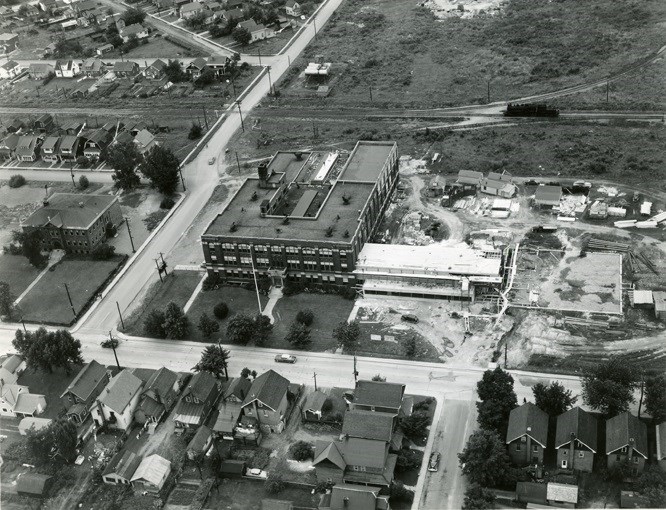From the archives of the Sault Ste. Marie Public Library:
In October 1945, a Sault Ste. Marie teenager went missing, launching a murder case that would span nearly five decades.
Theresa DeCourcy was 18 years old, the daughter of the local Registrar of Deeds. She was a student at the Technical High School, where she was described by The Globe and Mail as being “one of the most beautiful and popular girls at the school.”
She was heading to the Tech on the evening of Oct. 18 to attend a dance.
Witness accounts varied, with some saying she had not arrived at the dance at all, and others saying they saw her talking to a soldier outside. Regardless, she did not go inside, and she did not return home that night. Her parents, fearing for her safety, notified the police the next morning.
Some fellow students at the school heard that she was gone and began to investigate the area behind the school: vacant, bushy land near the CPR tracks. Some marks in the sandy earth caught their attention, and they followed the path for approximately 80 feet – straight to Theresa DeCourcy’s mutilated body.
Her body was found less than half an hour after she had been reported missing.
She was bruised, severely cut, and strangled. Police described that “[h]er blond hair and clothing were grotesquely disarranged and soiled, and her face, badly bruised, was covered by her hair. One of her shoes was missing from her left foot.”
She was, as reported in The Globe and Mail, “a ghastly sight.”
Police brought in teachers from the school to identify the body.
This wasn’t the only violent incident to happen in the city around the same time. Just one week prior to Theresa DeCourcy’s murder, another student from the Tech was the victim of an attempted rape near the same CPR tracks; the perpetrator said he would kill her if she told her parents. On the night of Theresa DeCourcy’s murder, two young women were assaulted near the same CPR tracks; one screamed and scared him away, and the other challenged him, asking “what the big idea was and [telling] him to beat it.”
ess than a week later, a woman would be attacked in her own backyard – and then receive a message in a bottle through her kitchen window reading “Don’t identify – I kill!”
While it wasn’t clear if all of the attacks were related, police believed they were dealing with a “sex maniac” who was responsible for at least some of the crimes. Sault Ste. Marie became “a city of dread” as people feared for their safety. Children stayed inside after dark. Jukebox joints were deserted. Victory loan canvassers found that people weren’t answering their doors as frequently. Clubs and restaurants that catered to teenage girls saw their attendance drop, particularly at night.
The Globe and Mail estimated that half of the women in the city were carrying hatpins as a weapon. The paper also noted that the city was “on the verge of near-panic” and, less tactfully, that it “needs . . . a sedative.”
City police offered a $500 reward in the murder case, which would soon increase with contributions from the Legion, and private citizens. City council also advocated for an auxiliary police force that could patrol overnight and make “our women folk and their children” more safe. The Canadian Legion volunteered to be involved in this patrol if need be. However, before anything official could be created, a group of approximately 100 citizens from neighbourhoods around the Tech formed a vigilante night patrol.
However, in terms of finding the killer and making an arrest, the police investigation, led by Det. Fred Rowe and Sgt. John Roswell, had little to go on. They interviewed and ultimately released all of their main suspects. Their only real clues were an army lanyard, potentially from a cadet uniform, a witness who saw Theresa DeCourcy talking with a soldier at the dance, and another witness who saw her arguing with a soldier on a previous occasion. However, that soldier’s identity was unknown.
As fears escalated, a man tried to grab a young woman’s purse, leading to a police chase. As the police arrested him, he started to scream, “I’m the killer. I’m the man who goes around molesting the girls. I’m the man you’re looking for.”
However, police determined that this was not a legitimate confession – the man was “nothing but a drunken crackpot” according to Police Chief Robertson.
The police had hit a dead end.
Check back next week to find out what happened next.
Each week, the Sault Ste. Marie Public Library and its Archives provides SooToday readers with a glimpse of the city’s past.
Find out more of what the Public Library has to offer at www.ssmpl.ca and look for more Remember This? columns here
